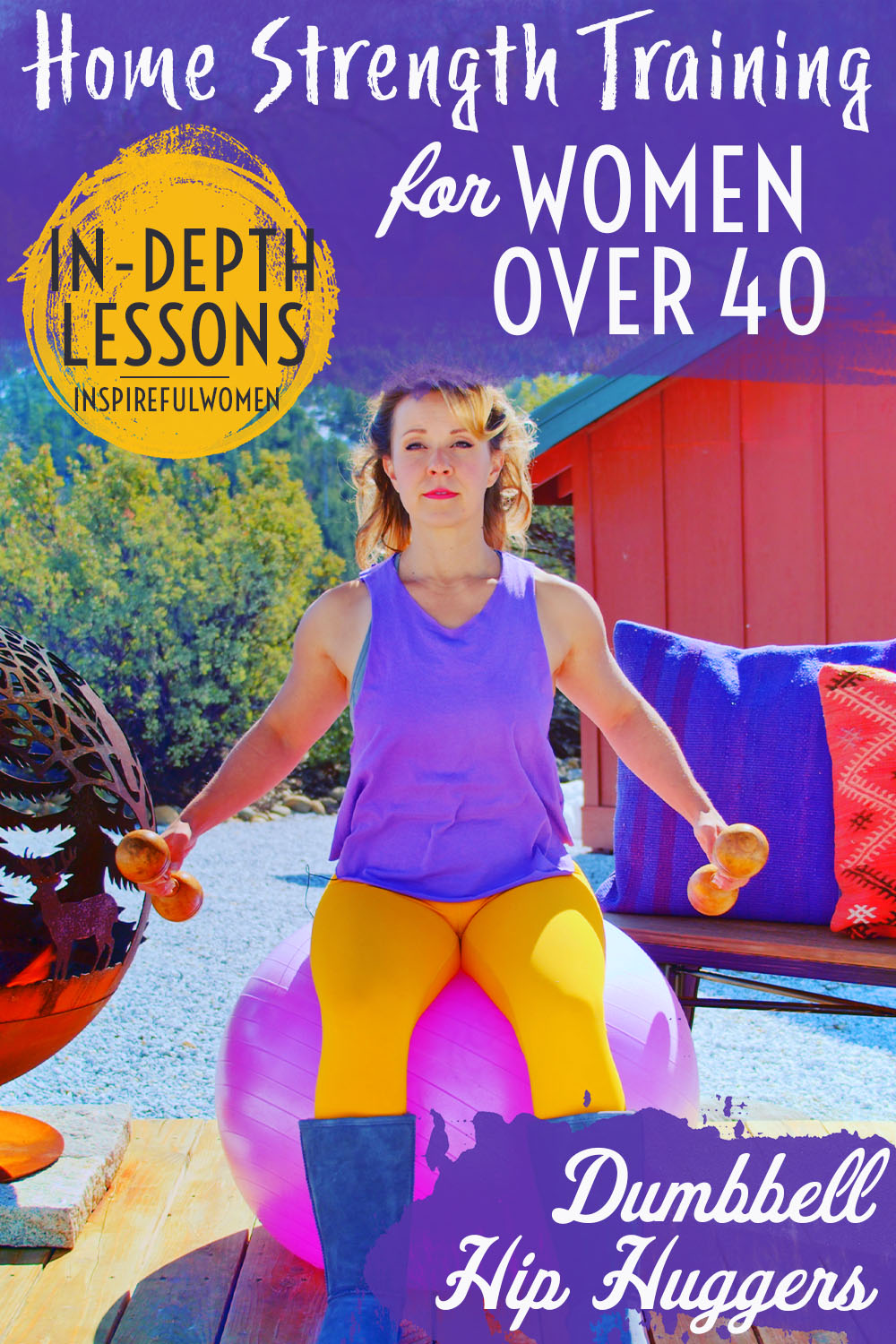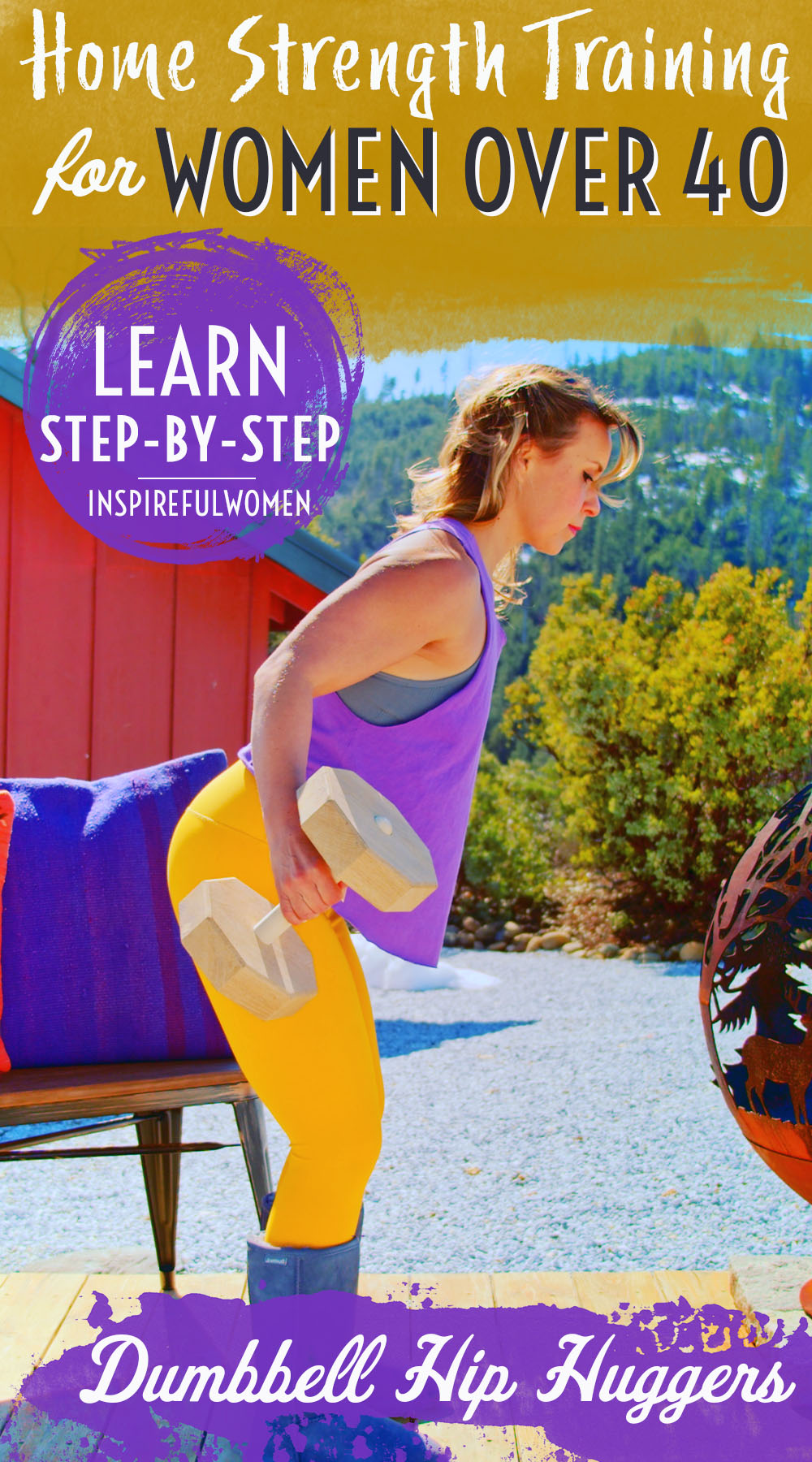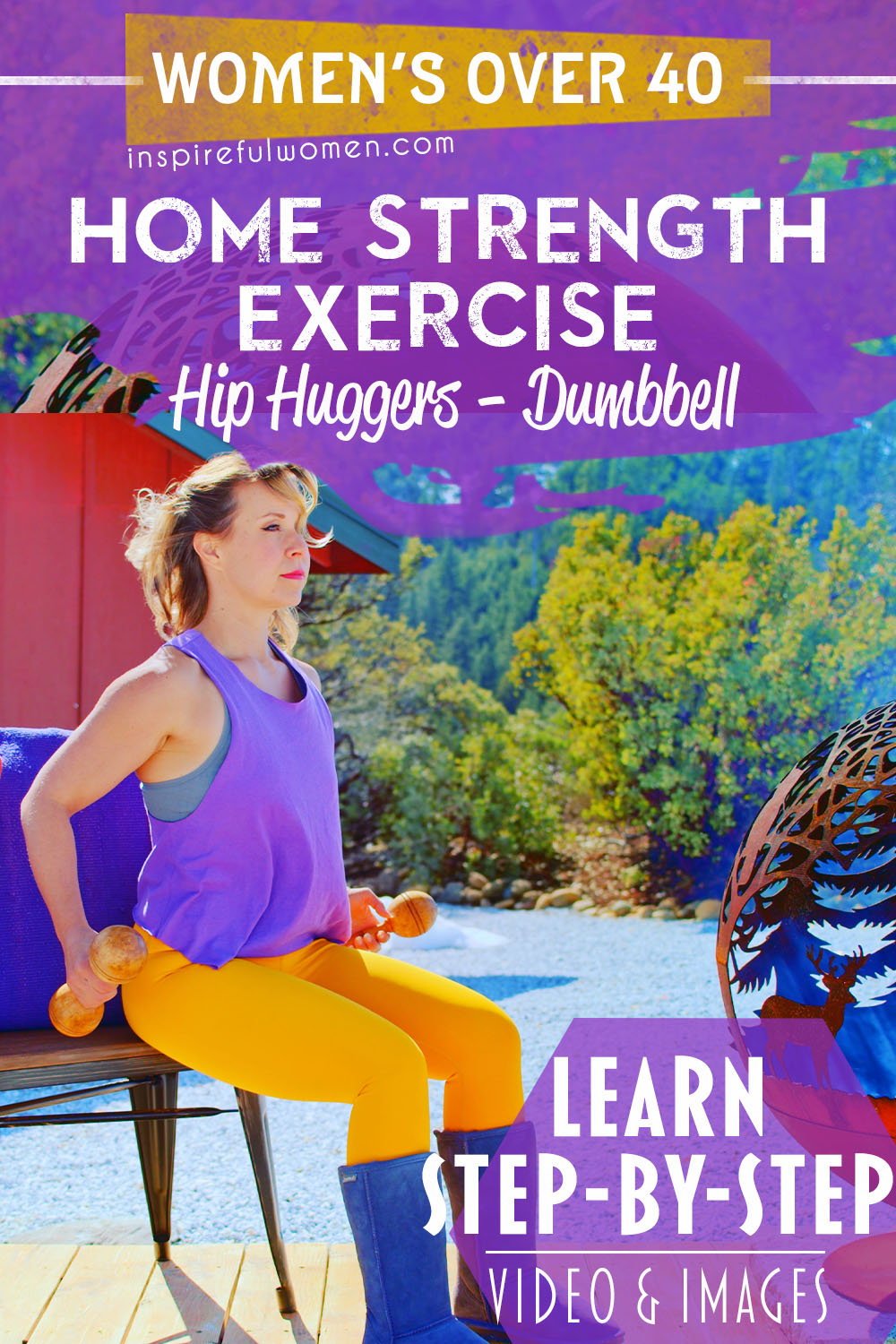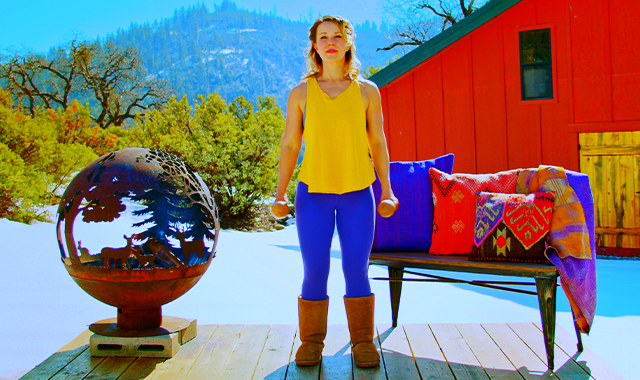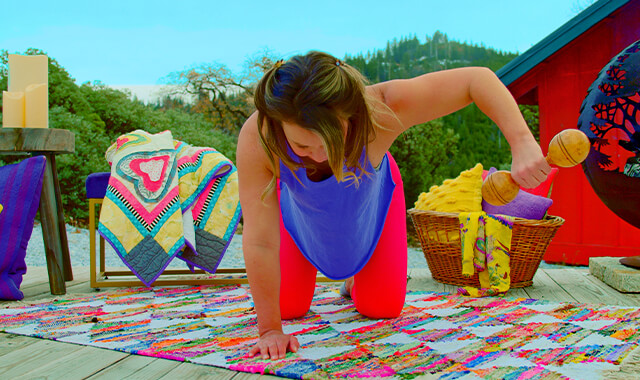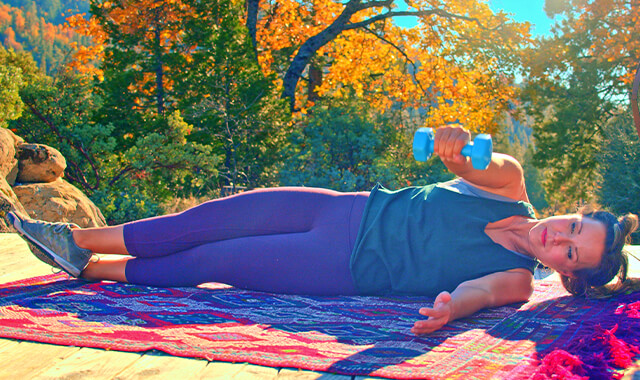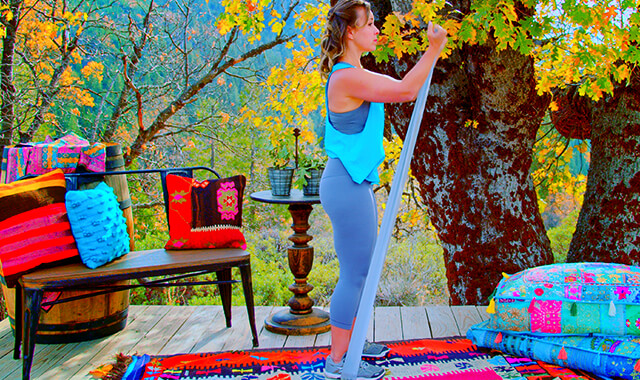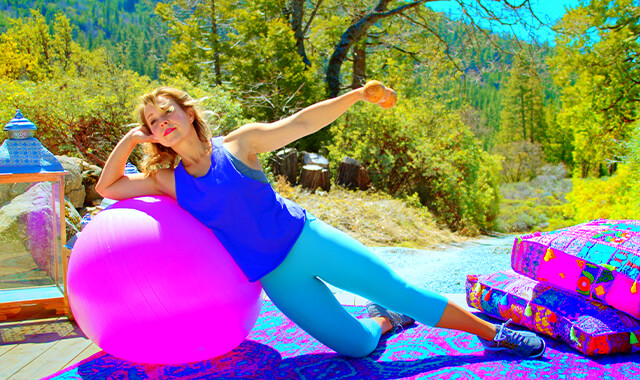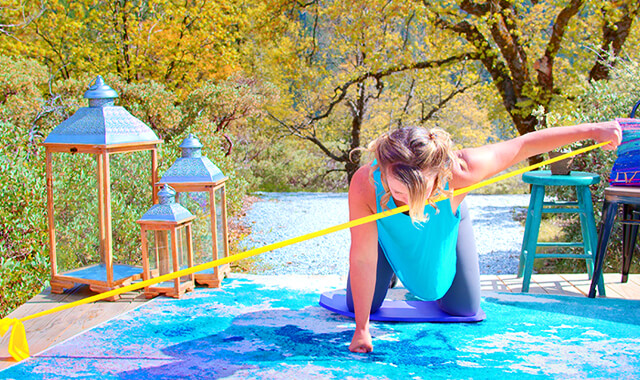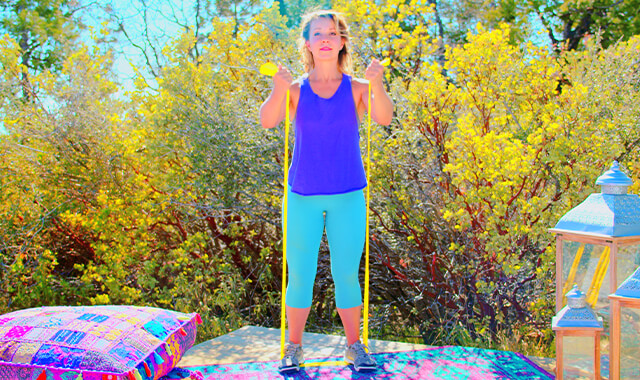Dumbbell Rear Delt Hip Huggers
How to Do the Hip Hugger Rear Delt Row - Dumbbell | In-Depth Guide [VISUAL LEARNERS] Beginner
Proper Form, Common Mistakes, Variations + Easier & Harder | Home Resistance Training
WHAT DO YOU WANT TO SEE?
QUICK DEMO
QUICK DEMO
MUSCLES THIS WORKS
MUSCLES
MAIN MUSCLES WORKED IN Dumbbell Rear Delt Hip HuggerS
Rear Deltoid
The rear delt is the back of your shoulder.
OTHER MUSCLES WORKED:
- All portions of the deltoid muscle; scapular muscles (pectoralis minor, subclavius, latissimus dorsi, lower trap, serratus)
- External rotators ( infraspinatus and teres minor).
WHAT WE'RE DOING TODAY
WHAT & WHY
BENEFITS OF TRAINING THE rear deltoid
WHAT
WHAT WE'RE DOING TODAY
ALL WE'RE DOING:
Using heavier dumbells, we're just going to pull our arms up and back 7-10 inches.
The Dumbbell Hip Hugger is an easy and beginner-friendly exercise that can help you target your rear delts. This exercise is a variation of the rear delt lateral raise which makes it a great way to work your back muscles as well. It can be done standing with weights.
This exercise is designed to work muscle on the back of the shoulder - the back (posterior or rear) part of the deltoid muscle. These muscles are worked by moving the arm back, and slightly behind the body. The rear deltoid also helps to rotate the arm the underside of the arm up.
The deltoid muscle is the large muscle that caps the top portion of the shoulder joint. This movement works the back (posterior or rear) part of the deltoid muscle that moves your upper arm back behind you. For the Hip Hugger exercise, you move your hands up close to the sides of your hips and torso, the elbows will bend as if you were pulling your pants up. At the top of the movement, the upper arms rotate forward.
WHY BOTHER DOING IT?
WHY
WHY DO WE EVEN CARE?
WORK THE SLIGHTLY IGNORED PART OF OUR SHOULDER MUSCLE
The deltoid muscle is the large visible muscle on the top of the shoulder. The muscle can be thought of as having 3 different parts, each part moves the arm in a different direction. The rear deltoid or posterior deltoid is the part of the muscle that lies on the back side of the shoulder. The other two parts of the deltoid muscle lift the arm to the front and to the side of the body. In our everyday lives, and even in our workouts, we spend a lot of time moving our arms to the front and to the sides of the body. We spend very little time moving our arms behind us.
This might make you think that the rear deltoid does not need to be strong. But it is important to know that all three parts of the muscle need to be able to work together to keep the shoulder joint healthy. The entire deltoid muscle works to stabilize the shoulder joint when you use your arm, and when you are lifting or carrying a heavy object. A well-balanced deltoid muscle is needed for healthy shoulder movement and posture. If you strengthen the front and middle deltoids but not the rear deltoids, then you will create an imbalance. Keeping all three parts of the deltoid muscle strong and healthy can improve posture, make lifting and carrying easier, and prevent injury. The rear deltoid raise also works the muscles of the back, including the muscles around the shoulder blade that work to correct a slumped posture position.
PROMOTES MORE CONTROLLED MOVEMENT OF OUR SHOULDER
It is interesting (at least to me) to think about how the muscles work. Muscles work together to coordinate movement, so even though one muscle is primarily responsible for a specific movement - if the other muscles are not balancing out the primary mover - our movement would be very uncontrolled.
For example: throwing a ball, even though the front of the shoulder and the chest muscles are doing most of the work to pull the arm forward forcibly, the back of the shoulder needs to be putting on the brakes - just the right amount at just the right time in order to control the movement. If the muscles on the front overpower the muscles on the back of the shoulder - the upper arm bone would move forward in the shoulder joint. Over time, this can damage the joint or the soft tissues of the joint.
WORKS THE REAR DELT FOR BOTH IT'S FUNCTIONS + BONUS ROTATOR CUFF WORK!
These exercises are designed to target the rear deltoid by working it into both it's main functions:
1. extension
2. external rotation
The exercise does a good job of working the rear delt at the same time as the rotator cuff muscles (infraspinatus and teres minor) which is important for establishing good movement patterns.
This exercise is done in a bent over position. To hold the position, the muscles of the back of the legs (gastroc/soleus, hamstrings and gluteus maximus) need to be active. The back extensor muscles will work to hold the torso against the downward pull of gravity. The resistance is pulled back (as opposed to pulled down or up at an angle) so the scapular muscles, especially the mid and lower traps, rhomboids, and serratus anterior will help with the movement.
LOOKS LIKE THE BOMB.COM
I think defined rear delts just look awesome on a woman! I'm not usually into trying to look all a certain way, but there's something super attractive to me about having nice shape in this area .
EVERYDAY LIFE
EVERYDAY LIFE &
MUSCLE FUNCTION
HOW WE USE OUR rear deltoid MUSCLES IN EVERYDAY LIFE
1. REACHING BEHIND THE BODY
- Tending a kid in the back seat
- Reaching into the back pocket
- Bringing the arm back to throw a ball (overhand)
2. PULLING
- Pulling a car door shut
- Pulling a refrigerator door open
3. ROTATING THE ARM UP (EXTERNAL ROTATION)
- Reaching the back of your head for washing, brushing your hair
- Pulling a shirt off over your head
- Reaching the top of a zipper
- Scratching your upper back
- Turning your outstretched arm with the palm up (need shoulder external rotation and forearm supination)
- Receiving change in the palm of the hand
4. WORKS WITH THE OTHER PARTS OF THE DELTOID MUSCLE (ANTERIOR, MIDDLE FIBERS OF THE DELTOID) TO STABILIZE THE SHOULDER JOINT
- Improves the ability to lift and carry heavy objects (the arm has a stable base to work off of).
- Injury prevention
STARTING POINTERS
Starting Pointers
This is a small movement. Only about a 7-10" pathway of movement. The dumbbell hip hugger works the rear delt in a short range of movement, as the upper arm moves back (extension) and (rotates so that the soft side of the upper arm is facing forward (external rotation).
The muscle is the strongest in this range so you might be able to lift heavier dumbbells to really get a concentrated contraction of the rear delt.
Most of the rear deltoid exercises are done with the arms held away from the body, this can limit the amount of weight that you are able to use successfully and safely. The hip hugger provides a nice addition to work the posterior deltoid with a heavier load.
The deltoid plays a big role in stabilizing the shoulder joint against a downward pull on the arm. All of the portions of the deltoid muscle work together to hold the arm bone (humerus) in the socket. As the weight pulls down on the arm, the deltoid contracts to pull the arm up. The hip hugger provides a way to strengthen the deltoid muscle to hold the arm up against a heavy downward pull.
HOW TO FEEL WHAT MUSCLE IS WORKING
How to Feel What Muscle is Working
Take your opposite hand and place it on top of your shoulder. You should feel a hard, flat surface right on top close to the shoulder joint. Drop your fingers right below the bony surface. Hold your upper arm up (approximately 50 - 60 degrees out to the side) with the elbow bent. Push the upper arm back. You should feel the rear fibers of the deltoid activate under your fingers. It can help to push your elbow into the back of the chair or a wall.
HOW TO DO THE EXERCISE
LOOKS
HOW Dumbbell Rear Delt Hip Huggers SHAPE OUR BODY
Toned, balanced, capped shoulders, good posture.
PROPER FORM
PROPER FORM: Dumbbell Rear Delt Hip Huggers
EQUIPMENT, SETS & REPS
EQUIPMENT
SUGGESTED STARTING WEIGHT FOR WOMEN:
2 Dumbbells, 8-10 lbs
SETS & REPS:
2 sets of 8 reps
PACE:
Moderate up and slower down.
BODY POSITION
BODY POSITION FOR THE Dumbbell Rear Delt Hip Hugger
FEET: Shoulder width apart, toes straight ahead.
BODY STANCE: Knees slightly bent. Shoulder blades pulled in and down your back. Sternum lifted, chest open. Abdominals gently engaged.
HAND/GRIP: Palms facing each other (neutral grip on the dumbbells), resting on the outside of your thighs.
ARM: Relaxed and hanging by your sides.
NECK: Neutral and relaxed.
HOW TO DO
HOW TO DO Dumbbell Rear Delt Hip Huggers
CUE: Rushing the movement can result in using your biceps to pull the weight up instead of the rear deltoids. Think of pulling your elbows up instead of pulling your hands up.
Begin the movement by pulling your upper arm upwards (backwards relative to the torso), as you lift the weight up along the side of your body. The weights travel close to your body but not touching your body.
Let your elbows bend as your upper arm moves behind the body. The weight will be lifted approximately 8 - 10 inches - starting by your thighs and ending around the level of your belly button. The elbows will flare out from the torso - just let this happen naturally.
Towards the end of the movement, rotate your upper arm out - so the peak of the biceps muscle (soft underside of the arm) is facing forwards. Your hands will move away from the sides of the body. Rotate it out as far as possible and hold the position for a pause (less than one second).
Return to the starting position by reversing the rotation and lowering the dumbbells back down with control. Keep a slight bend in your elbow joint at the bottom of the movement (between reps) to keep the stabilizing muscles active.
HOW TO SAFELY GET OUT OF THE EXERCISE
From the starting position, squat down and set weights on the floor.
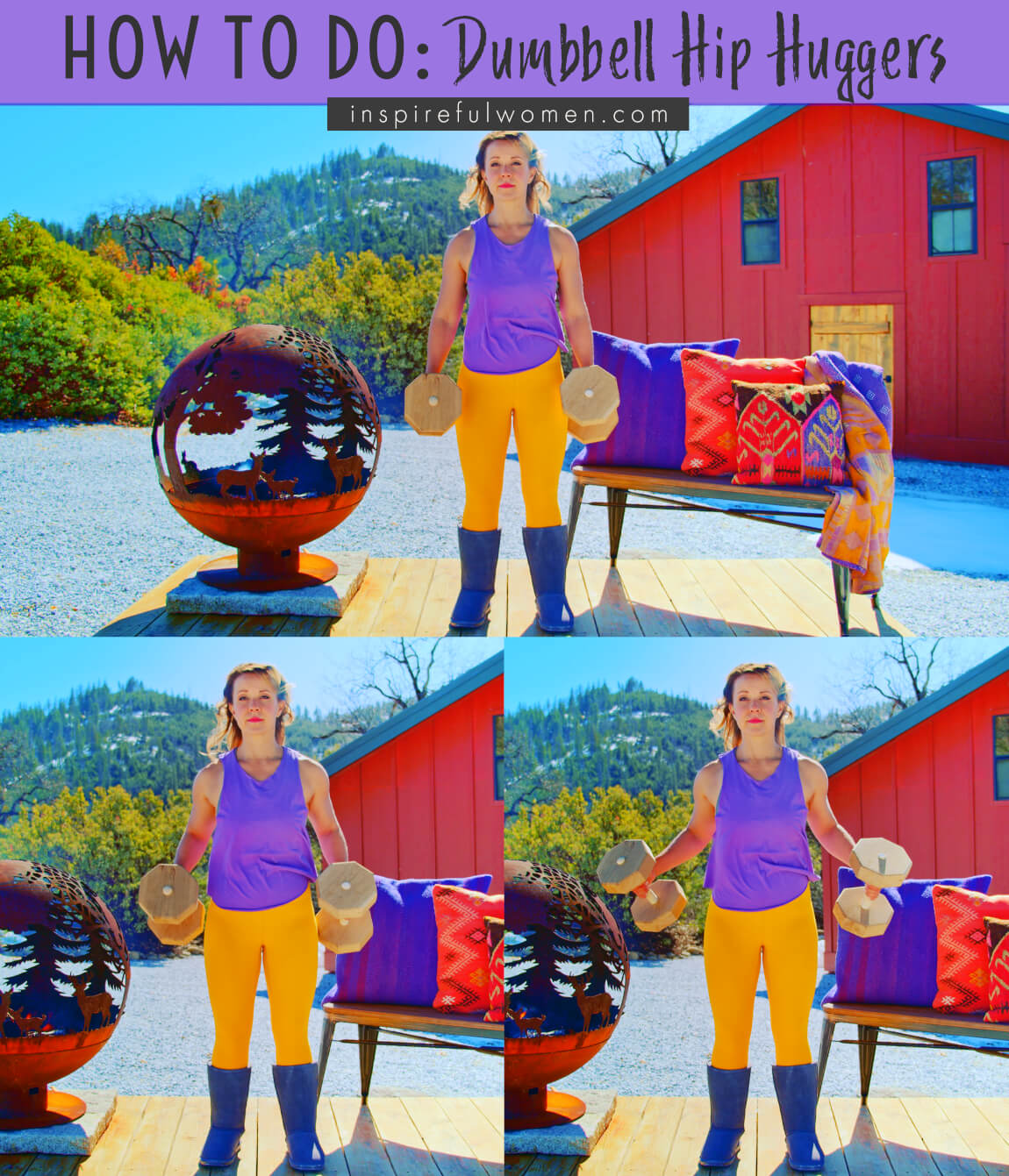
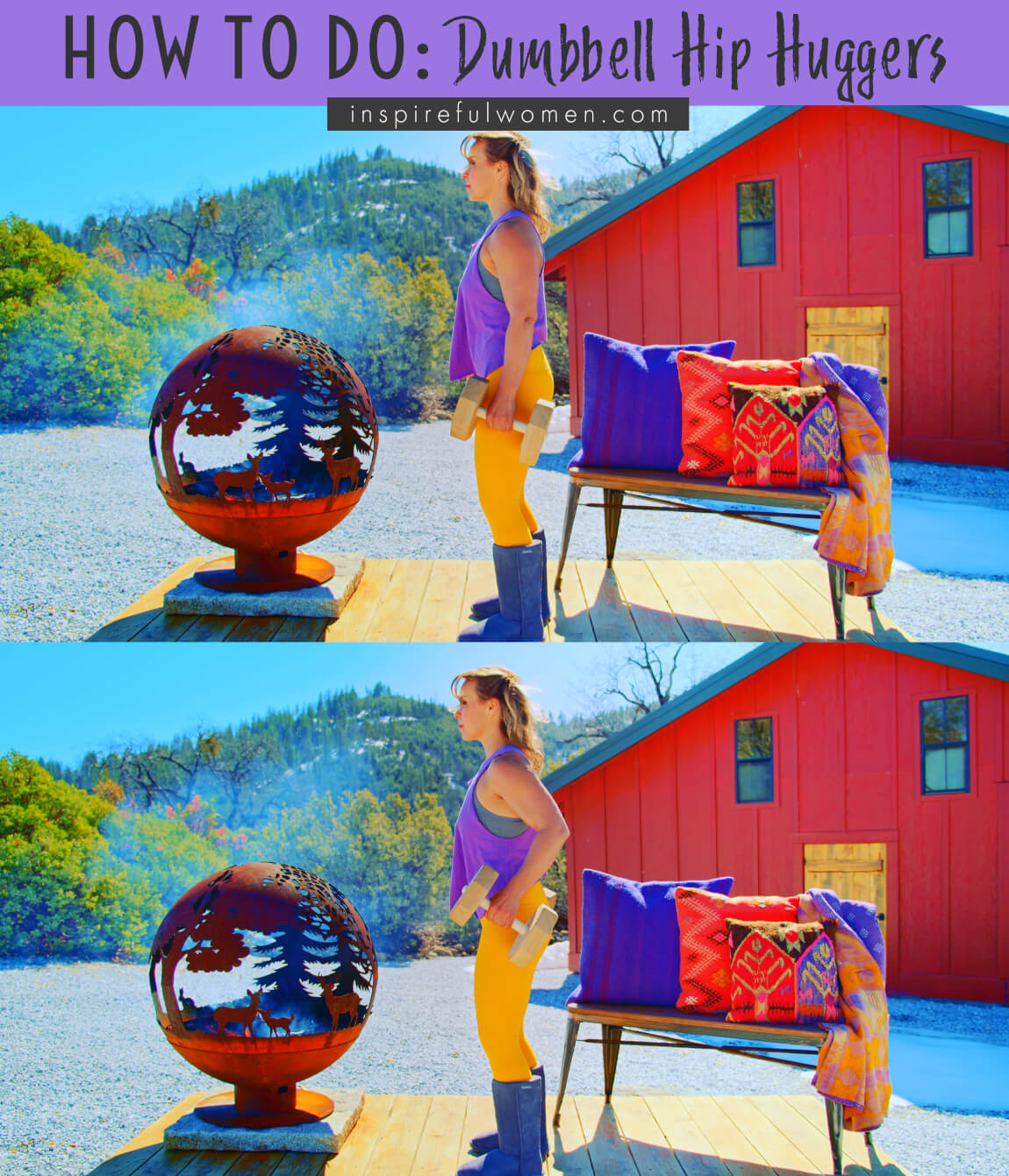
COMMON MISTAKES
COMMON MISTAKES
WHAT TO AVOID WITH THE Dumbbell Rear Delt Hip Hugger
KEY TIP:
Guess what? Good news! Many avoids are the same for most movements. Once you learn the basics, there's really only a few extra avoids for each individual movement.
1. Avoid arching your back
AVOID: Avoid arching your low back.
WHY NOT?
- Can lead to low back joint injury, muscle strain, or damage over time.
WHAT TO DO:
- Maintain a neutral spine position.
- Troubleshooting suggested fixes
- Poor core strength: activate your abdominal muscles, or do choose a position with more support.
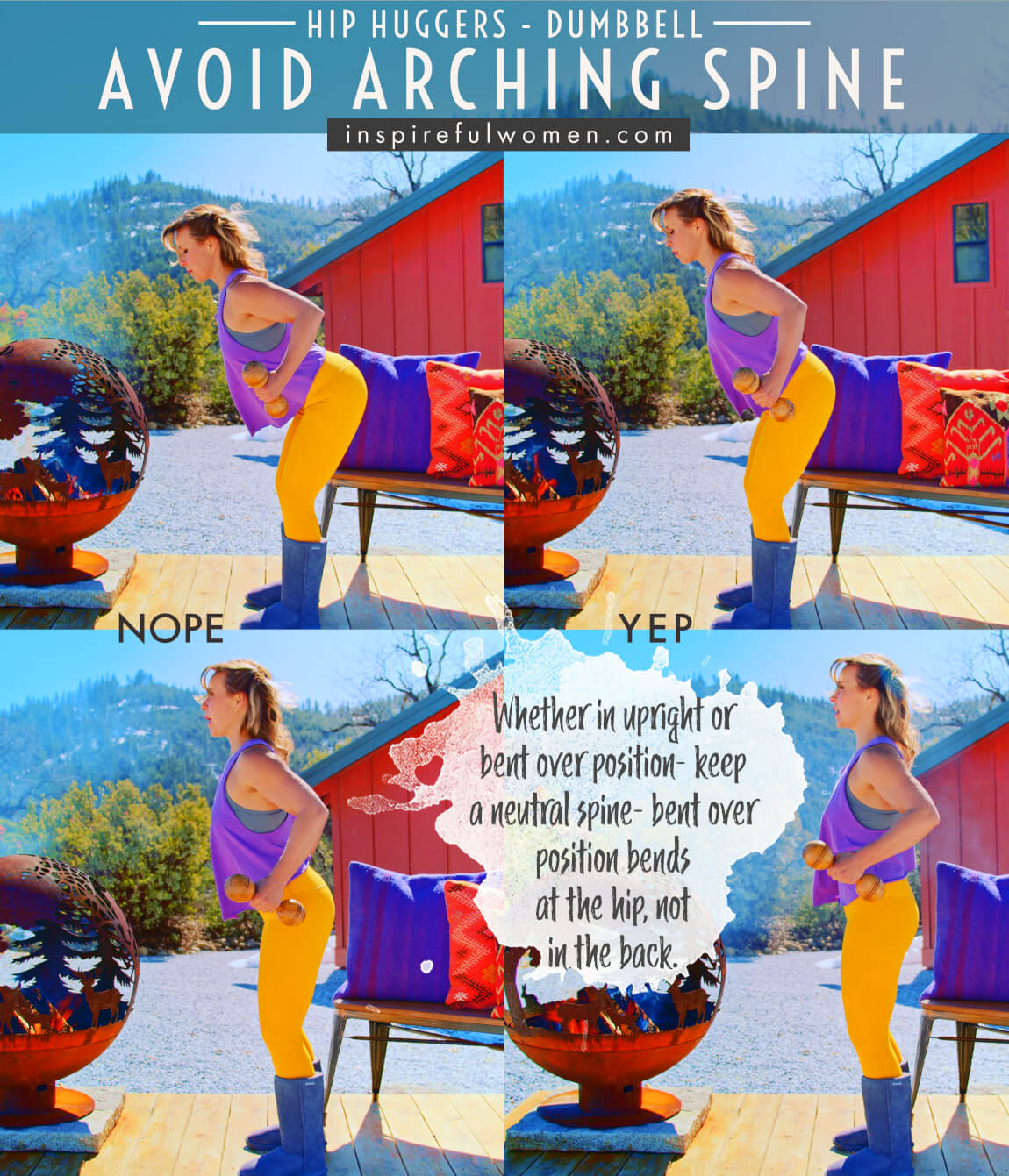
2. Avoid bending the wrist
AVOID: Avoid moving through your wrists.
WHY NOT?
- Poor alignment (bent forward or backward) or repetitive movement through the wrist can lead to joint and/or soft tissue irritation or injury over time.
WHAT TO DO:
- Your wrists should be in line with your forearm and should be still throughout the exercise.
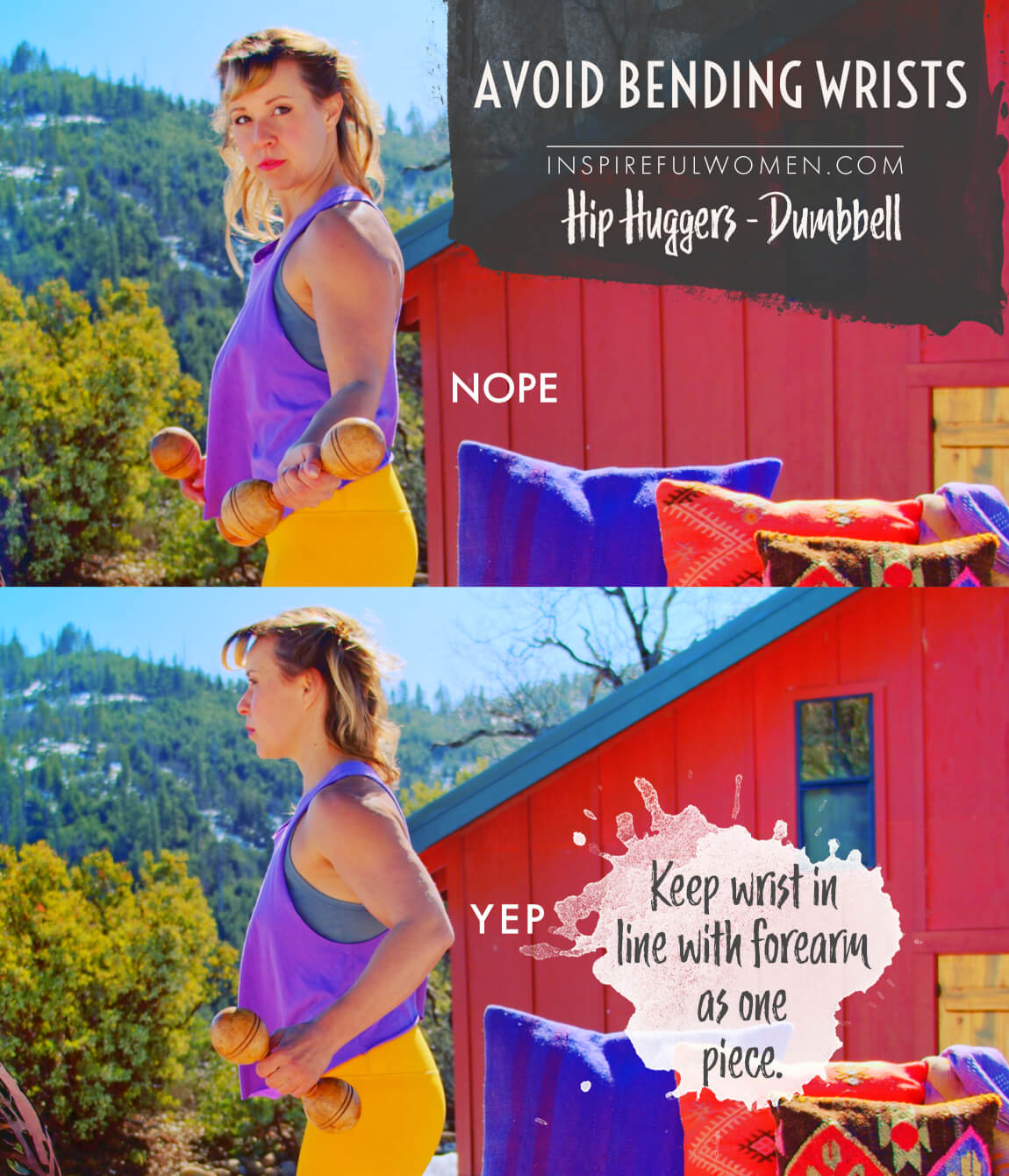
3. Avoid locking your knees
AVOID: Avoid straightening or locking the knees of standing legs.
WHY NOT?
- This tends to decrease the lumbar curve, pull on the hamstrings and decrease the muscle activity of the legs.
- Locking the knees puts stress on the knee joint and can make it more difficult to maintain a neutral spine.
WHAT TO DO:
- If you feel pressure or discomfort in the low back or knees, try bending the knees.
- Keep the knees soft, with a slight bend.

4. Avoid actively bending your elbows
AVOID: Avoid letting your upper arm drop down as you rotate your arm.
WHY NOT?
- This will take the tension off of the deltoid and will decrease how much the muscle is working.
WHAT TO DO:
- Keep the upper arm lifted and concentrate on rotation of the bone in the socket.
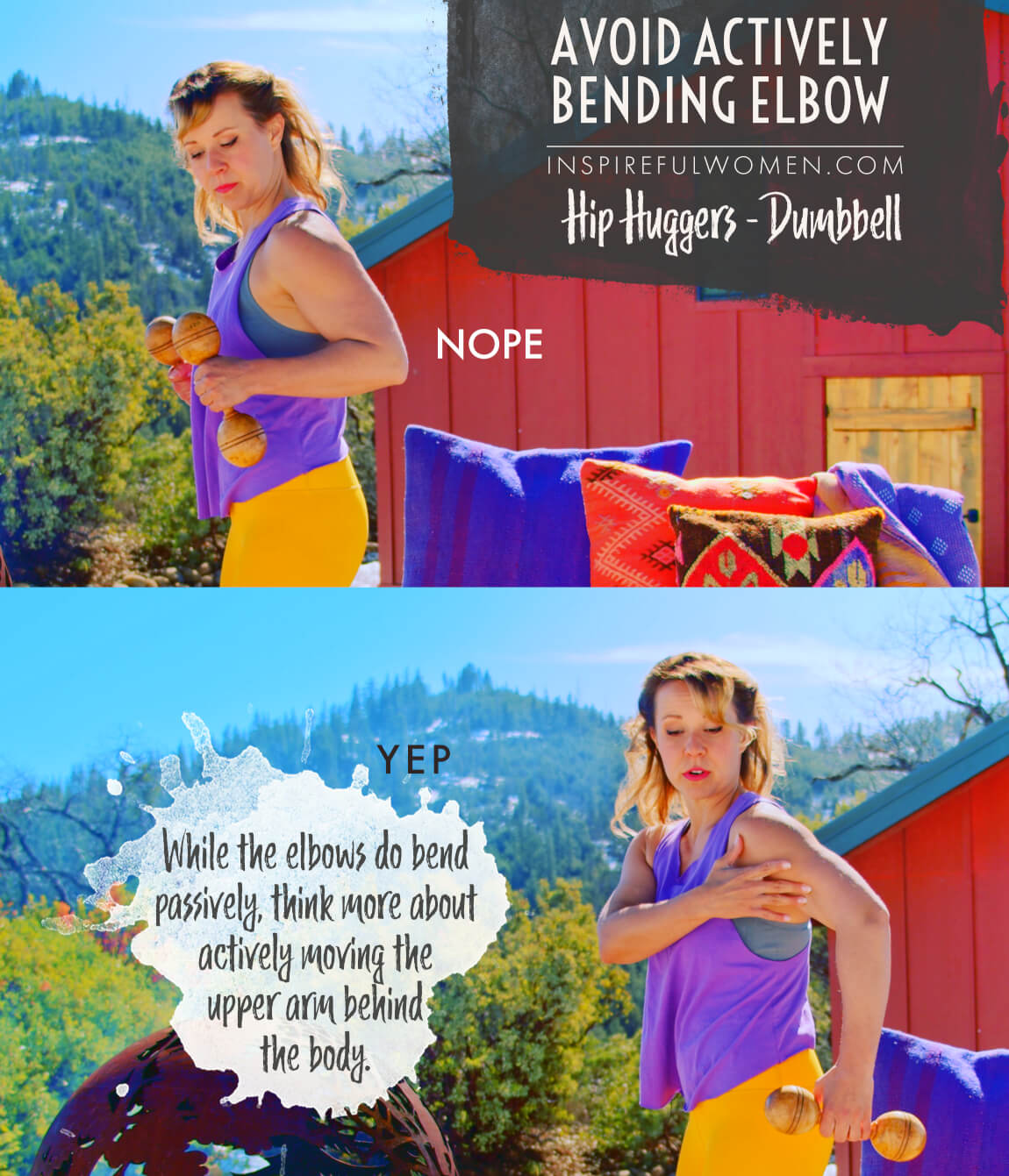
5. Avoid turning palms up
AVOID: Avoid palms facing up.
It's not that your palms won't start facing up- they actually will. But the point is, the actual movement should be coming from the movment at your shoulder joint, and the palms will just be passively turning upward as a result, versus purposefully flipping our forearm so that the palm faces up- that uses different muscles, not the rear delts.
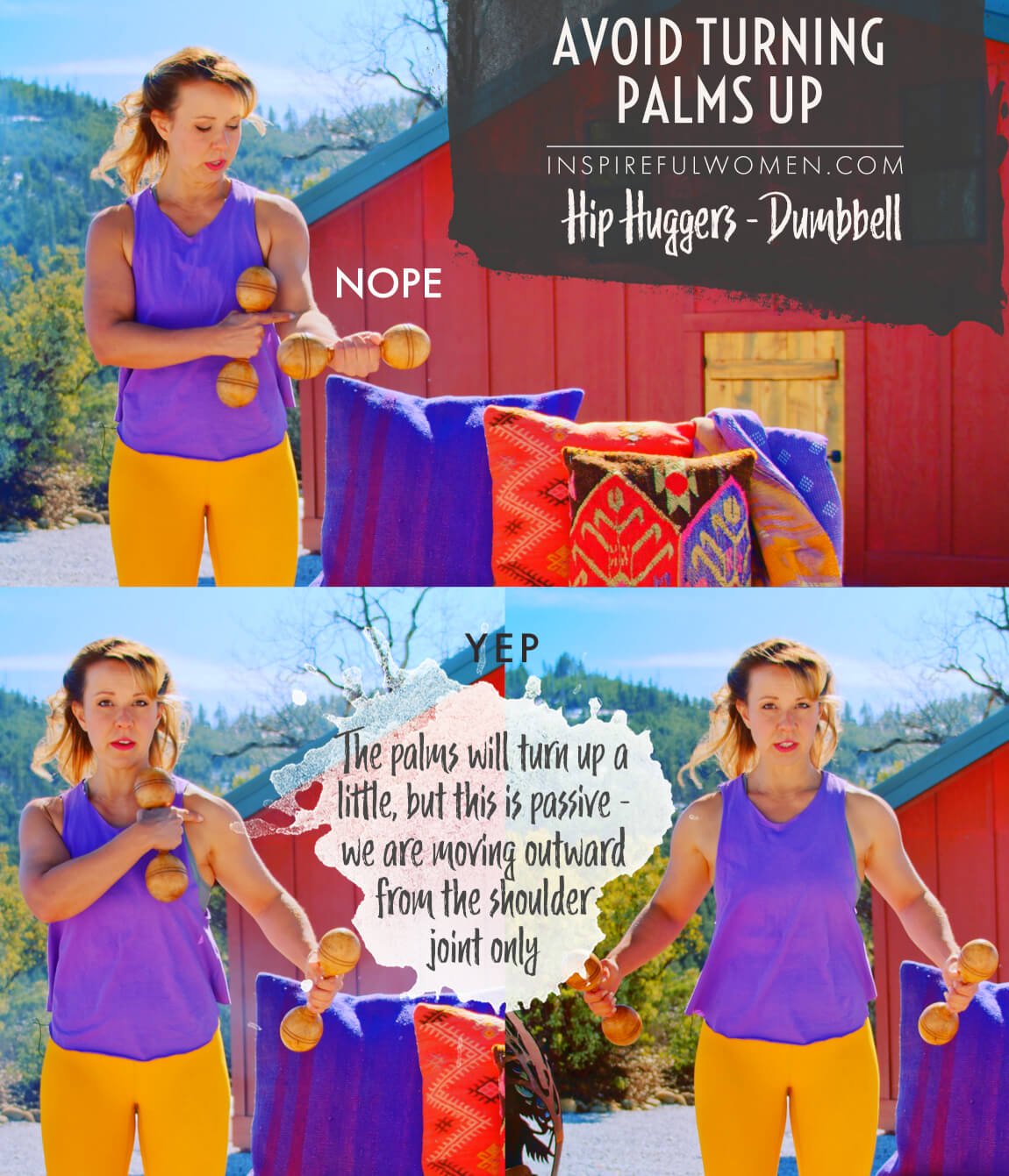
6. Avoid not only rear delt move
AVOID: Avoid not only rear delt move.
WHY NOT?
- This movement involves a pretty small range of motion and it's best to work our muscles through their full range.
WHAT TO DO:
- Do other rear delt exercises as well like rear delt raises and rear delt flys.
7. Troubleshoot: Feeling in Biceps
AVOID: Avoid turning the movement more into a bicep curl by bending the elbows only instead of really using the shoulder to move.
WHY NOT?
- The thing that works our rear delt muscle is when we move from the shoulder joint to pull the arm up and back. If the shoulder doesn't move and we only bend the elbows, this will only be working the biceps.
WHAT TO DO:
- Make sure that as your arms move that you are actively pulling backwards with your shoulders.
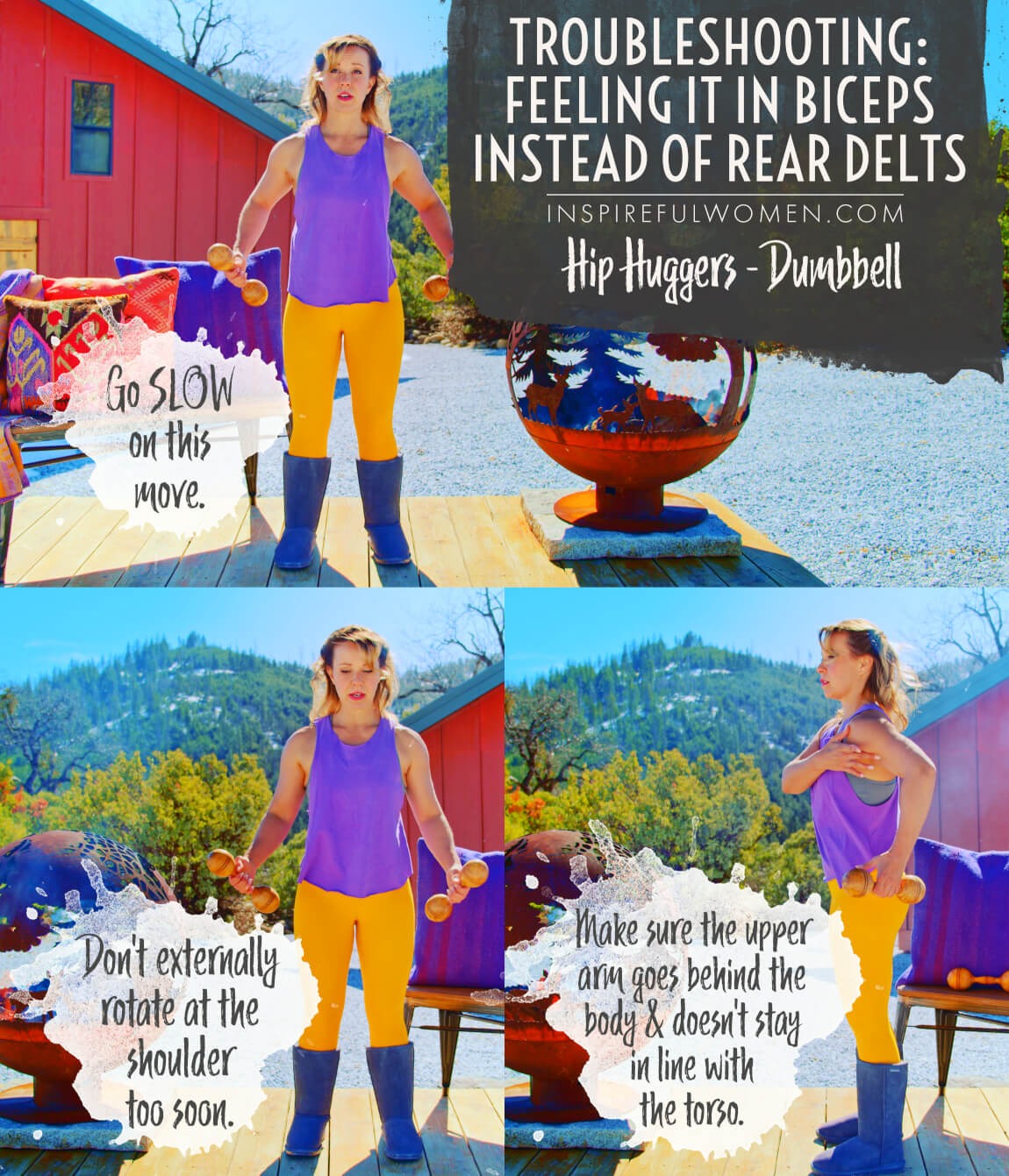
VARIATIONS
VARIATIONS
VARIATIONS OF Dumbbell Rear Delt Hip Huggers
Bent over
Bent over rear delt hip hugger
This exercise can be done in a forward-leaning position to help feel the posterior deltoid more. Hip hinge forward at approximately 30 -40 degrees then complete the exercise as above. How far you lean over should be dependent on comfort and core strength. The farther you lean forward the more the core will need to work to maintain a neutral spine.
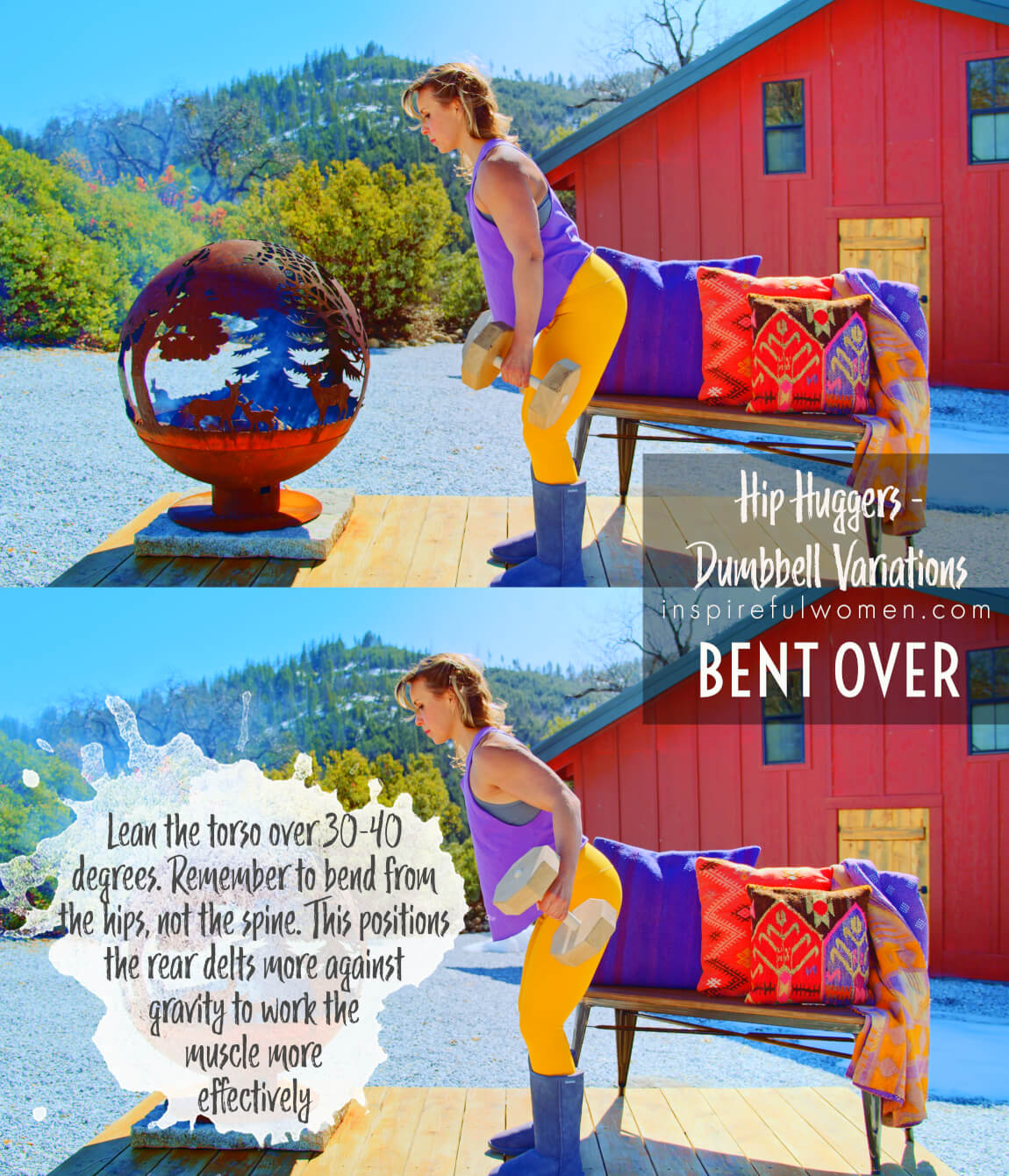
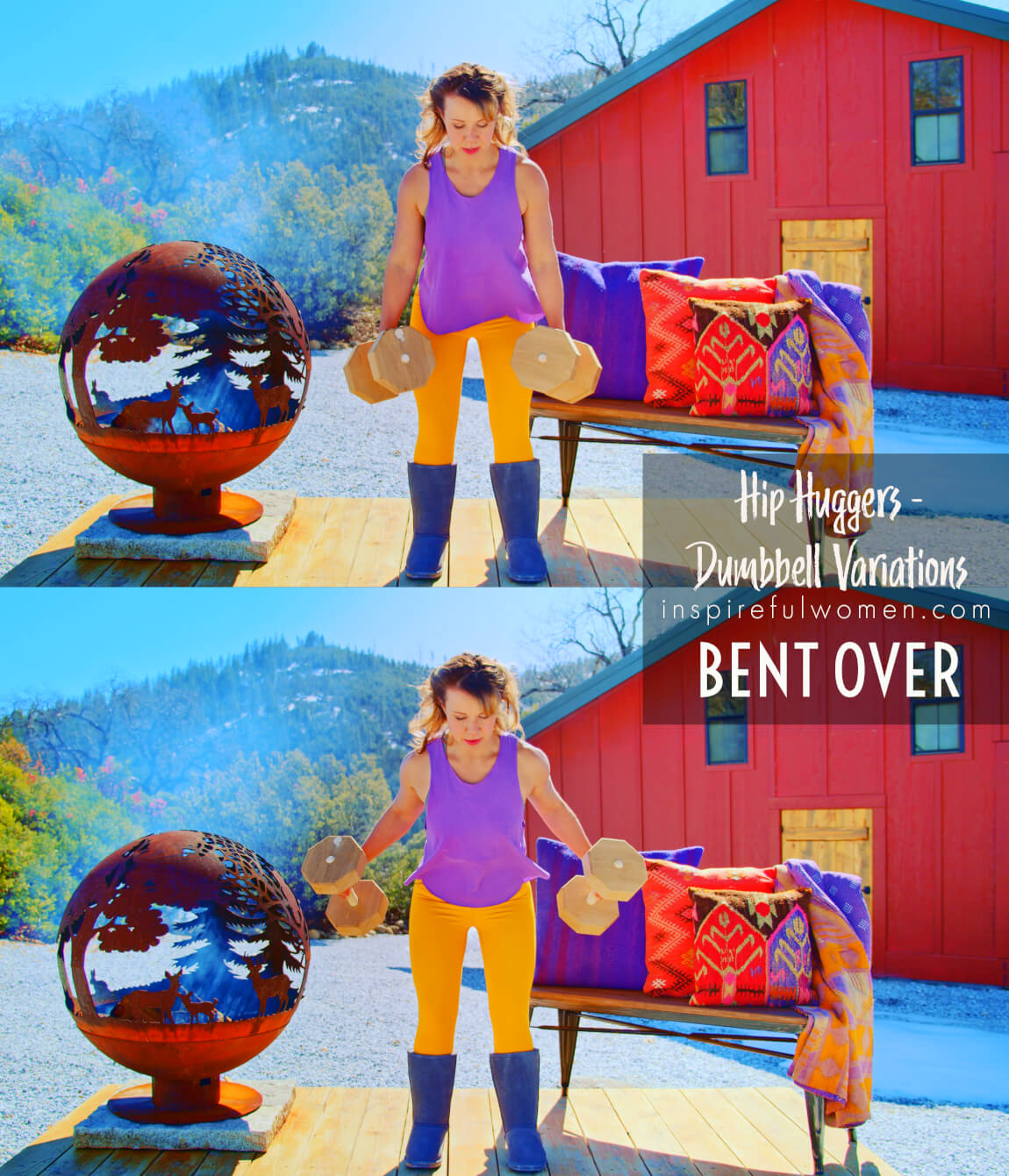
Start in external rotation
Starting with shoulders in external rotation
Hold the weights in front of the thighs - your upper arm rotated so that the weights are perpendicular to the feet. Lift the weights up as the upper arm moves back behind the body. The upper arm is held in external rotation throughout the exercise. This variation is nice if you have difficulty coordinating the upper arm extension and external rotation.
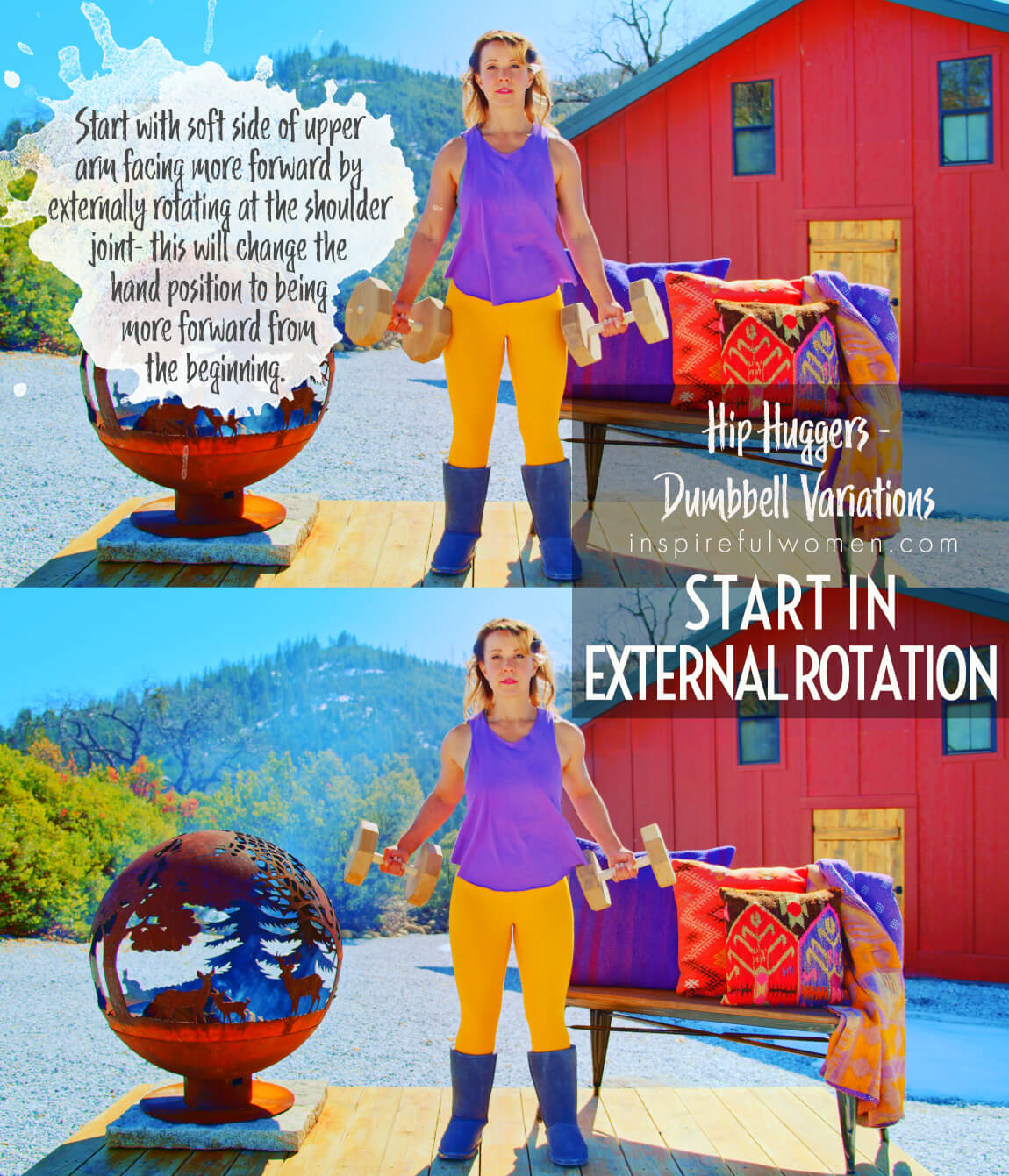
Single arm
One arm hip hugger
One arm at a time. This helps you focus on one arm at a time. It will work the muscles of the core a bit differently - more quadratus lumborum (to prevent side bending) and obliques (to prevent rotation). Avoid side bending or rotating the torso.
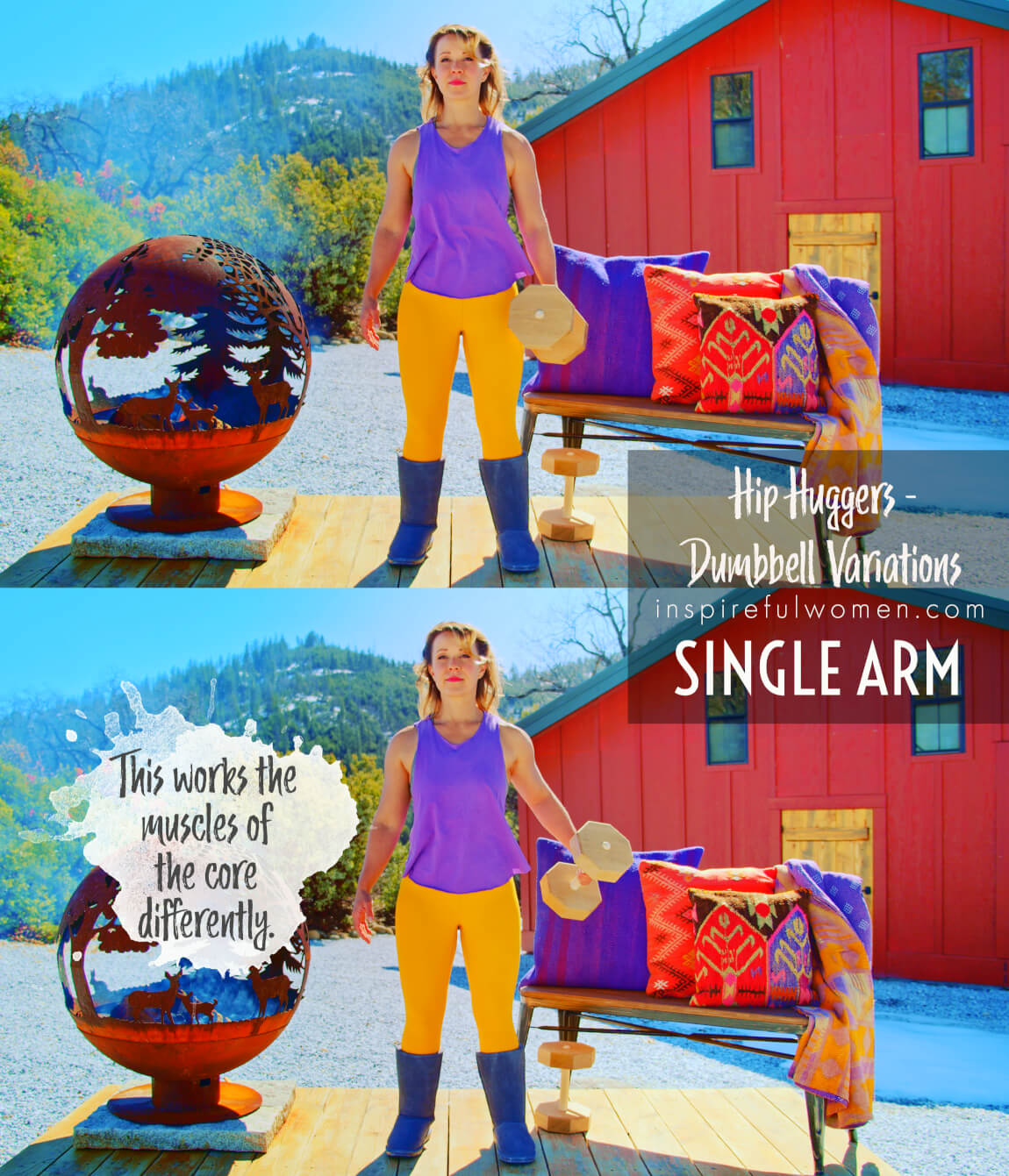
Alternating
Alternating arms hip hugger
Alternating left and right. This adds more challenge to the core muscles - they will need to respond differently with each lift to stabilize against the alternating force. Do not rock or sway the torso. One arm at a time. This helps you train both arms equally and focus on one arm at a time. It will work the muscles of the core a bit differently - more quadratus lumborum (to prevent side bending) and obliques (to prevent rotation). Keep equal weight bearing in your left and right foot.

MAKE IT HARDER
HARDER
MAKING THE Dumbbell Rear Delt Hip Hugger MORE CHALLENGING
Iso Hold
Isometric Hold Dumbbell Hip Hugger
Hold at the end of the range for 3-5 seconds (for each rep)
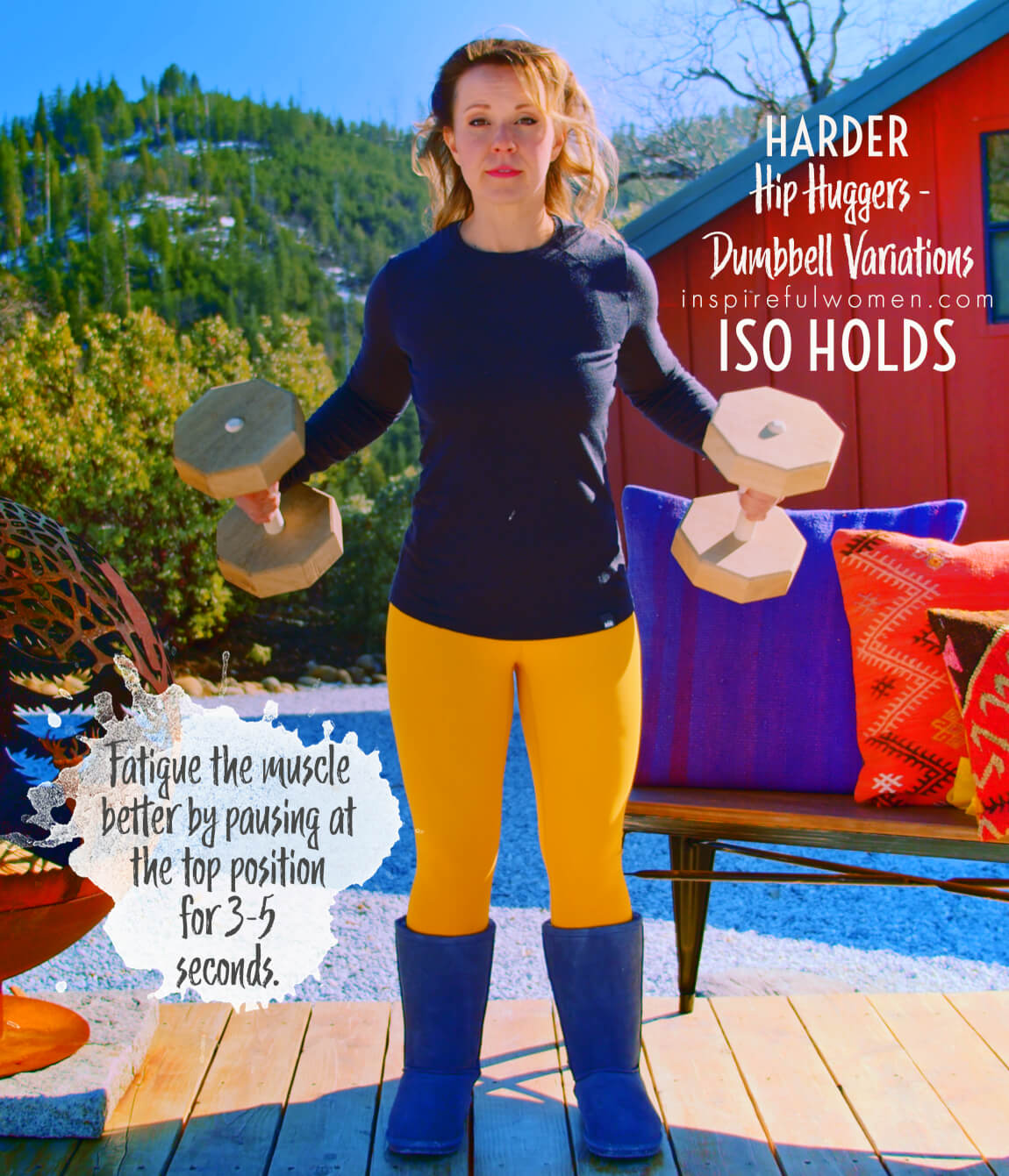
Pulsing
Pulsing Dumbbell Hip Hugger
Pulse 5 times at the end (with upper arm held in external rotation) of the range (for each rep)

MAKE IT EASIER
EASIER
MAKE THE Dumbbell Rear Delt Hip Hugger MORE DOABLE
Omit external rotation
Omit external rotation hip hugger
Omit the upper arm external rotation. Only complete the upper arm extension. Lift the weight up along the side of the body. Pause at the top of the movement and lower back down. Keep the chest wide and the shoulders back.
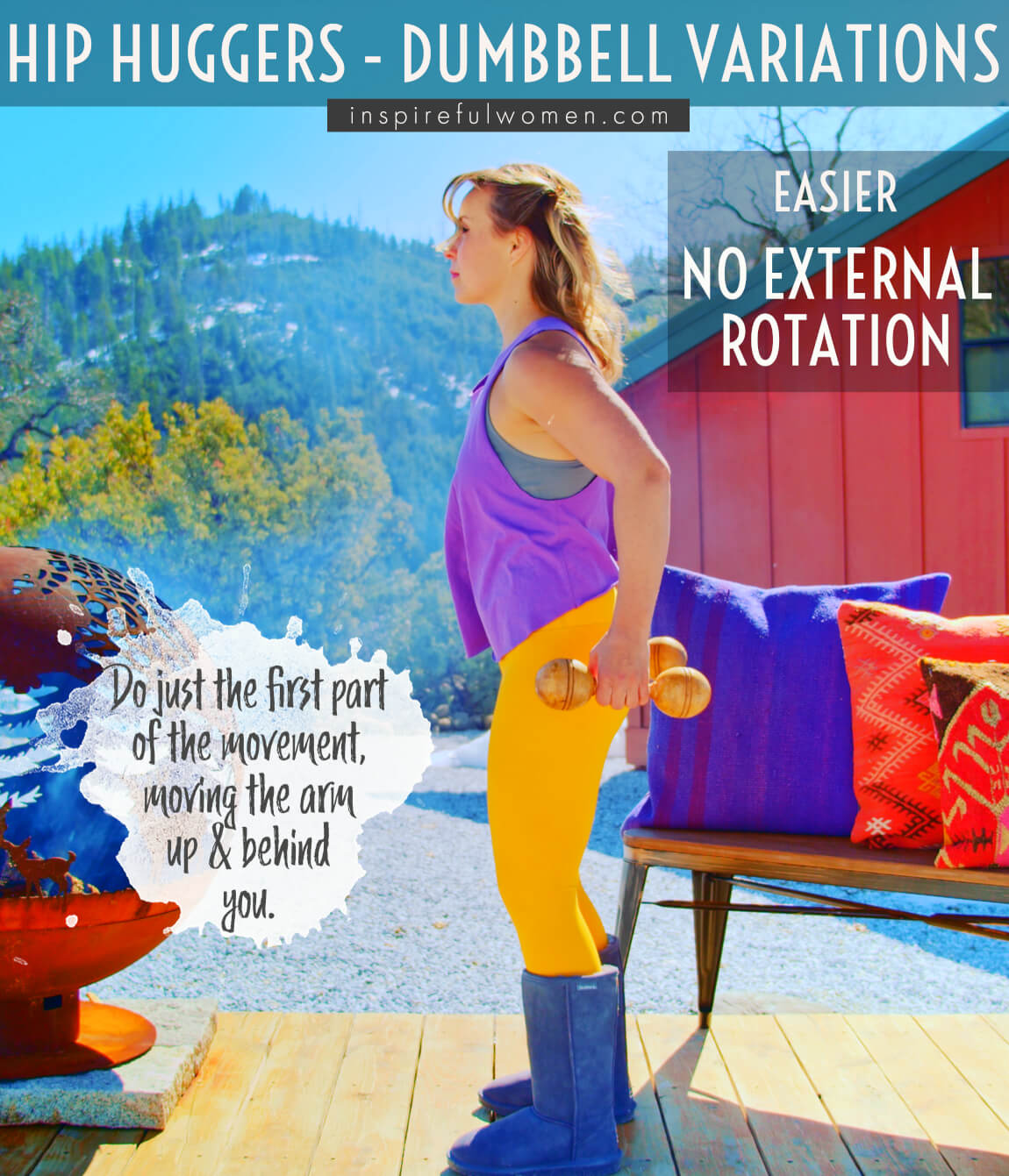
External rotation only
External rotation only
Omit the upper arm extension part of the movement. If you are having difficulty with the external rotation of the upper arm - do only that portion of the movement until you have better understanding and control. Holding the weight at belly button height, rotate the upper arms out. The hands will travel out away from the body as the upper arm rotates.
Seated on a chair
Seated on a chair
This be done seated on a chair. Make sure that you are sitting forward so the range of movement of the arms and shoulder blades is not affected. The seated variation will decrease the amount of work your core muscles are doing.

Stability ball seated
Seated on Stability Ball
This can be done seated on a stability ball. Make sure that the spine is in a neutral position and the trunk remains very still. Will work the core muscles more than seated on a chair, but less than standing. It is ok if the weights start out in front of the ball as long as the elbows and upper arms move back behind the body as the weights are lifted up.
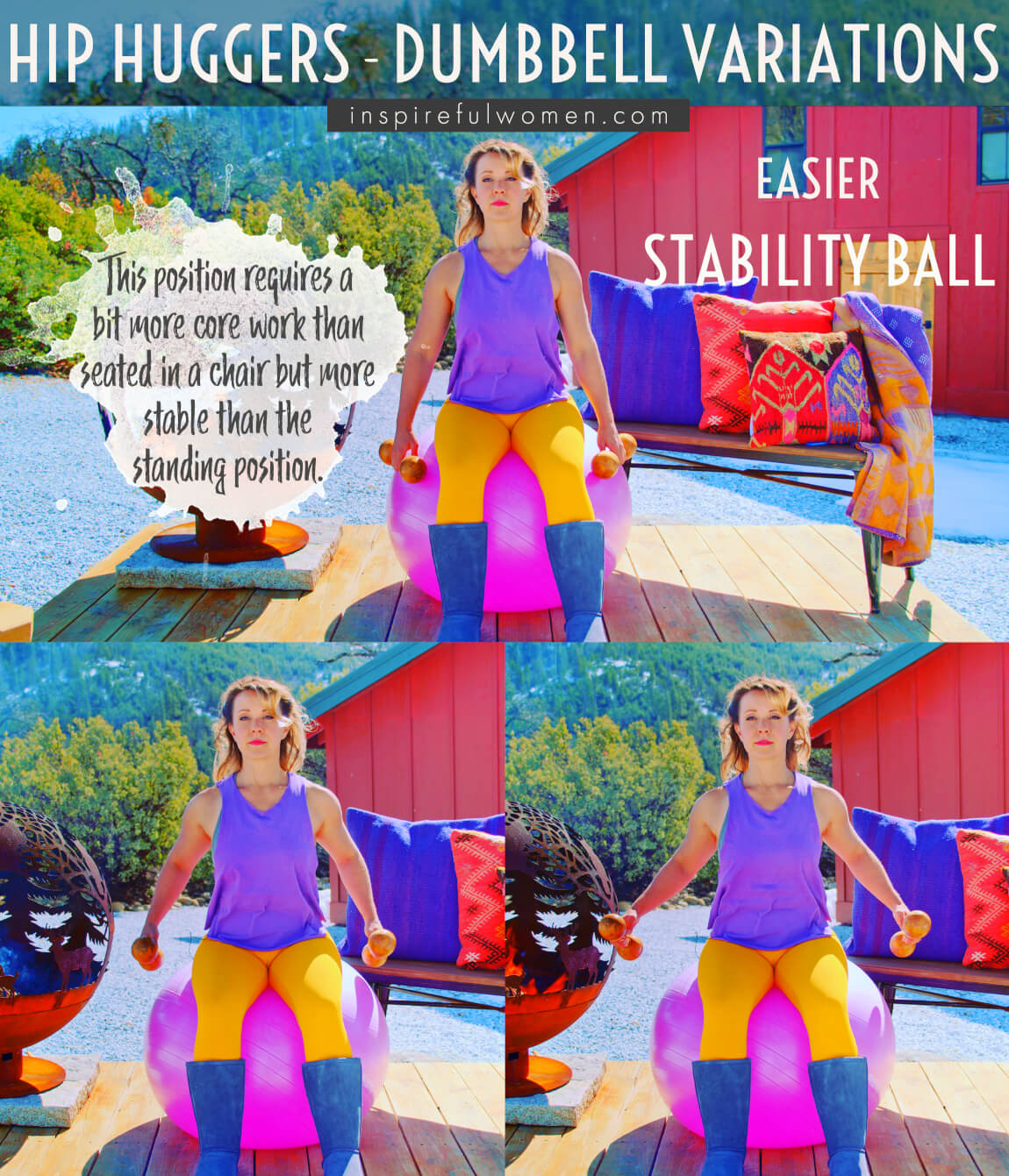
SCIENCY STUFF
ALLLL MUSCLES & WHEN
ALL MUSCLES WORKING & WHEN DURING THE Dumbbell Rear Deltoid Hip Hugger
The muscles of the shoulders, arms, and forearms work to stabilize the shoulder, elbow, and wrist against the traction (downward pull of gravity pulling the joints apart) of the joints. All portions of the deltoid muscle are active isometrically for resisting the downward pull of gravity, to hold the arm in the socket of the shoulder blade. The heavier the weight, the more they will be working.
To begin the scapula is depressed (pectoralis minor, subclavius, latissimus dorsi, lower trap, serratus). As the upper arm lifts up, the lower trapezius, rhomboids, and latissimus dorsi contract concentrically to move the shoulder blades together (scapular retraction).
As the weight is lifted up, the prime mover of the arms are the posterior deltoids working concentrically, the long head of the triceps may help a bit, especially under heavy loads. Towards the end of the movement, the posterior deltoid, infraspinatus, and teres minor work concentrically to externally rotate (turning the underside up) the upper arm.
PIN IT FOR LATER!
